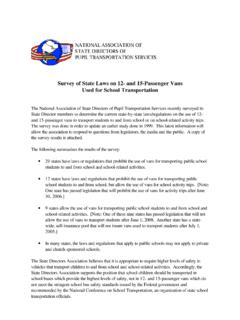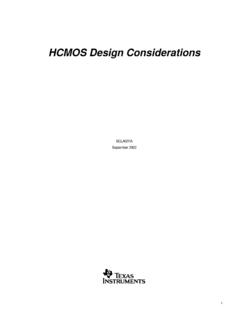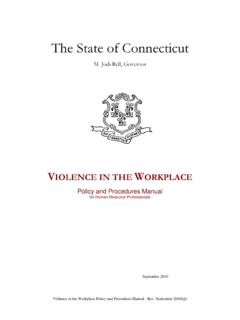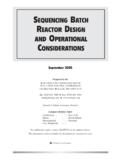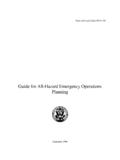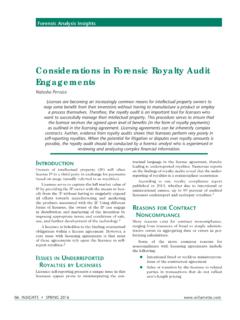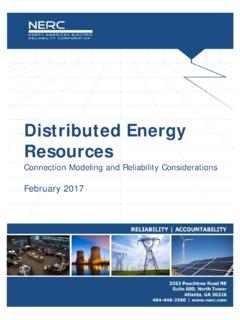Transcription of Information Report School Bus Replacement Considerations
1 Information ReportSchool Bus Replacement ConsiderationsBackground: School buses represent the largest bus operation in the country, and provide more tripsto passengers than transit buses. There are nearly 450,000 School buses operating inthe United States. These buses safely and efficiently transport nearly 25 millionchildren to and from School and School -related activities. In an average School year, School buses provide approximately 10 billion student trips and have the best safetyrecord of any vehicle on the road. School buses come in various designs andcapacities. Some are constructed on van chassis and carry less than 20 are built on unique School bus chassis and can carry nearly 90 , School buses across the country have numerous differences in terms oftheir standard and optional equipment.
2 The School bus fleet is composed of buses ofvarious ages with different mileage accumulations. It is a remarkable fleet of :Are there factors that should be considered when developing and implementingpolicies for determining how long a School bus should be used for schooltransportation purposes?Discussion:This Information Report is not intended to dictate precise School bus replacementpolicies, since there are multiple issues at state and local levels that are involved insuch decisions. However, the National Association of State Directors for PupilTransportation Services believes the timely Replacement of School buses must be aplanned process.
3 The Information contained in this Report is intended to provideinsight into the factors (safety, efficiency, environmental, maintenance, operationalconditions, etc.) that are involved in making decisions concerning School busreplacement funding is likely the single most important consideration in determiningwhen School buses are replaced. That being said, there appear to be at least twoscenarios that should have an impact on decisions concerning School bus , whenever there is a significant improvement in the federal standards for thesafety, fuel efficiency or exhaust emission requirements of School buses, it appearsreasonable to establish a policy with respect to timely Replacement of the older buseswith newer School buses.
4 A good example of this occurred in April 1977 when thePage 2 National Highway Traffic Safety Administration issued a set of stringent FederalMotor Vehicle Safety Standards for School buses. Since then, the federal governmenthas maintained a policy that pre-1977 School buses should be replaced at the earliestpossible time. Fortunately, most states and local School districts no longer operatepre-1977 School buses, and the few that remain typically are used as reserve or back-up School buses. Other examples include the diesel emission requirementsimplemented in 1988 and the substantial changes to the School bus emergency exit andexterior mirror requirements made in the early determination of what constitutes a significant improvement is something thatmust be defined by those that choose to incorporate this concept into their logic fordetermining when to replace a School bus.
5 For some improvements, it is likely that aconsensus of what constitutes significant could be achieved easily. For other items,it may be impossible to get everyone to agree on the importance of the is reasonable to assume that there will be continued improvements in the FederalMotor Vehicle Safety Standards that apply to School buses. Some of thoseimprovements will likely apply to passenger safety, while others may be directed atavoiding crashes, and still others to driver safety. At the same time, federalrequirements and recommendations with respect to fuel efficiency and vehicleemissions will likely continue. Unless School bus Replacement plans are developedand implemented, these improvements in safety, efficiency and cleaner air will notreach their desired goals in a timely , whenever the operating and maintenance expenses on a School bus, or groupof School buses, reaches a certain level, it appears that the better economic decisionwould be to purchase a new bus rather than continue to maintain the older School is the classical cost/benefit analysis.
6 Do the benefits of buying a new School busoffset the costs?It is widely accepted that it is more costly to operate and maintain older School busesthan newer School buses. However, the vehicle age at which the total operating costsof an older bus versus a newer bus becomes intolerable is not an exact science. In themid-1980s, independent studies of annual School bus operating costs were conductedin California and Washington. Both studies reached the same conclusion after 12years of use, the annual operating costs of Type C and D School buses began toincrease significantly and continued an annual increase each year January 2000 study of life cycle costs for Type D School buses in South Carolinaindicated that 15 years should be adopted as the cycle for School bus study also noted that School buses that accumulate mileage more quickly, such asthe special needs School buses in South Carolina.
7 Should have their life cycle costanalyses based on mileage accumulation not 3No studies of life cycle costs for Type A and B School buses were found. Sincethese types of School buses are of a lighter duty design, it appears likely that theywould have slightly shorter anticipated lifetimes than Type C and D School those studies suggested a rule-of-thumb for large School buses in general, it isclear that maintenance and operating cost data on individual School buses may providethe Information needed to better define when individual or groups of School busesshould be replaced. For example, reviews of individual School bus maintenance costsmay identify buses that can be operated longer or which should be replaced is commonly accepted that good preventive maintenance reduces the frequency andcosts of breakdowns and the resulting corrective maintenance.
8 Likewise, the terrainand road conditions over which School buses operate can have an impact on thefrequency and cost of maintenance. Additionally, the climatic conditions in the areacan impact maintenance costs. The environmental conditions of how and whereschool buses are stored can directly impact the useful life of various components;especially those made of plastic, rubber or bus breakdowns result in several problems. First is the cost of towing andrepairing the School bus. Second, breakdowns on the home-to- School trip result in lossof classroom time for students, a particularly important point for schooladministrators.
9 Third, a breakdown could increase the risks to children while theywait in or near the broken down School bus for a Replacement any cost/benefit analysis there may be discretion in terms of defining all of theitems that fall under the benefits category. Clearly reduced maintenance andoperating costs are benefits. But what other items are included and how are theycalculated? For example, what is the value of having a School bus that has the latestsafety or emission features? Does the cost of insurance on the School bus reflect that itcomplies with the latest federal and state safety requirements? How much does riskmanagement figure into the calculations?
10 ConclusionsUnfortunately, there is no silver bullet answer to these and other , accurate and thorough records on the operating and maintenance costs (bothpreventive and corrective maintenance) of all School buses in a fleet will provide thedata necessary to analyze and understand costs. Information from insurancecompanies and risk managers can be obtained that are specific to your state or schooldistrict. With solid data and Information , it is easier to make informedrecommendations and 4 Establishing School bus Replacement policies is an important activity, since it directlyimpacts the timeliness of introducing the latest safety, efficiency and emissionsimprovements into the fleet.
